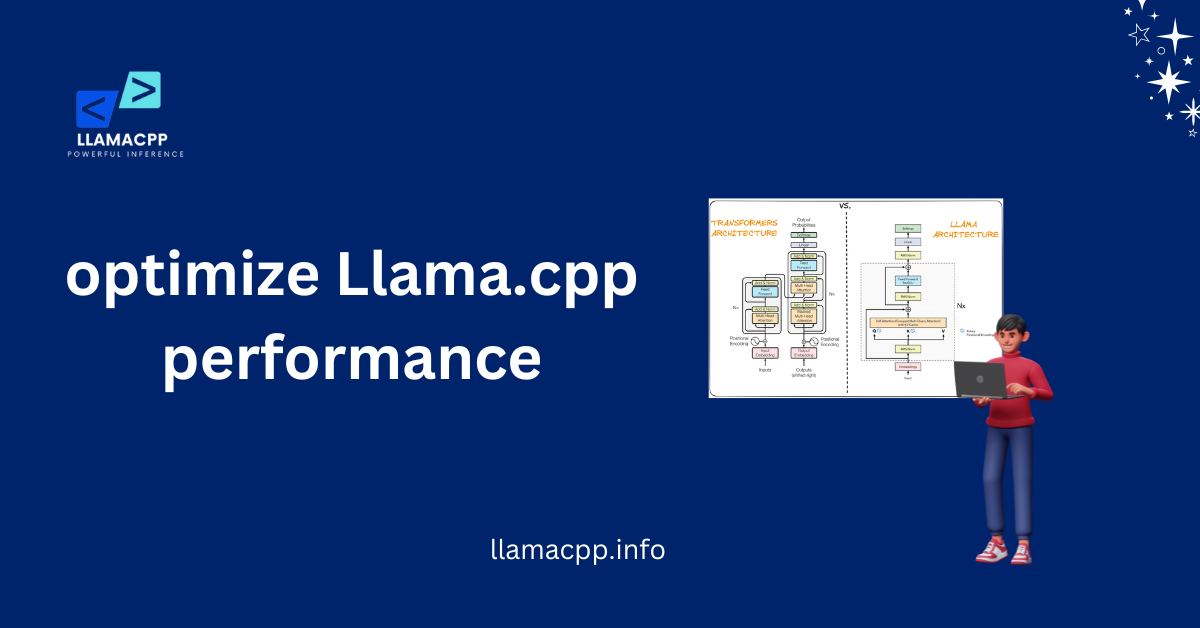Table of Contents
ToggleIntroduction
To make AI work better, run multiple models in Llama.cpp. The tool Llama.cpp lets you run language models on your phone or tablet. A lot of people want to know if it can handle more than one model at once. Running multiple models can speed up chores and improve results. But does this feature work with Llama.cpp? That’s what this guide is all about.
We will see if Llama.cpp can run multiple models in Llama.cpp and discuss any problems you might have. This guide is for you if you want to speed up AI work without having to pay a lot for cloud services. Let’s get right to it and see how it works!
How do I open Llama.cpp?
- Llama.cpp runs AI models by loading pre trained weights and performing inference on CPU or GPU.
- It processes input data, applies model computations, and generates predictions or responses.
- Supports optimization techniques like mixed precision, GPU acceleration, and memory management for efficient execution.
Do you know how Llama.cpp works?
- Llama.cpp works by loading pre trained AI models and performing inference on either CPU or GPU.
- It processes input text, applies the model’s computations, and generates outputs like predictions or responses.
- The tool supports optimizations such as GPU acceleration (CUDA/ROCm), mixed precision calculations, and efficient memory management to improve speed and performance.
Why work with Llama.cpp?
These files can help people who want to run AI models offline. It gets rid of the need for pricey cloud services. People who work on AI like it because they have complete power over their models. It also works on different running systems, making it flexible.
Another reason to use it is peace of mind. Llama.cpp runs on your device, so no one else can see your information. This tool is excellent if you need AI processing but don’t want to share your data.
Is it possible to run more than one model in Llama.cpp?
Yes, but it’s different for each system. When you run a lot of models at once, you need more memory and computer power. I Ifur system isn’t strong enough.
If it could slow down or crash, you want to run more than one model in Llama; you need to be good at managing resources.cpp. Some users change settings or use special hardware to get better speeds. In the following sections, we will discuss how to do this effectively.
Can Llama.cpp Run Multiple Models at Once?
- Yes, Llama.cpp can handle multiple models, but it depends on your system’s CPU/GPU and memory capacity.
- Each model requires its own memory allocation, so sufficient RAM and VRAM are essential.
- You can load models sequentially or in parallel using separate instances of Llama.cpp.
- Using GPU acceleration helps manage multiple models efficiently and reduces inference time.
- Monitor system resources to avoid crashes or slow performance when running several models simultaneously.
What happens to performance when you run multiple models in Llama.cpp?
When you run multiple models in Llama.cpp, your system needs more RAM and CPU. If your device has limited resources, it may struggle to keep up, which can cause lag, crashes, or slow replies.
To prevent this, you should check how much your system can hold. Adding more RAM or a faster processor can help make things run faster.
What Are the System Requirements?
Check your hardware before you try to run Llama.cpp vs other AI frameworks. It is best to have a computer with a powerful processor and at least 16GB of RAM. More RAM lets you do more things at once and makes things run more smoothly.
If your system isn’t very strong, you might want to run one model at a time. This keeps things stable and prevents crashes.
Can Llama.cpp be made better for more than one model?
Yes, you can make Llama.cpp run faster when you use more than one model simultaneously. Some users change the settings to better control their memory, and others split the work using tools from outside the company.
Changing settings and closing apps that aren’t being used can also help. These steps make it easier for your system to handle more than one model.

How to Run More Than One Model in Llama.cpp
- Open separate terminal instances for each model you want to run concurrently.
- Place each model in its own dedicated directory to avoid file conflicts.
- Launch Llama.cpp with the appropriate command line flags (
--gpu,--use-cublas, or--use-rocm) for each model. - Adjust batch size, context length, and precision for each model to optimize memory usage.
- Monitor CPU, GPU, and RAM usage to ensure stable performance while running multiple models.
Step 1: Run a resource check on your system.
Check your system specs before running more than one model in Llama.cpp. It’s best to have at least 16GB of RAM and a powerful CPU. run multiple models in Llama.cpp at once may slow down or crash your machine if it doesn’t have enough memory.
You can also see how the system is being used while models are running. This can help you determine whether your machine can handle more.
Step 2: Load each model separately.
In Llama.cpp, load each model one at a time to run more than one. If you run them together without setting them upright, errors can happen.
Some users open a different terminal window for each model. This can help spread out the work and prevent the system from getting too busy.
Step 3: Make things work better
When you run multiple models in Llama.cpp, There are ways to make them run faster, such as closing apps you’re not using to free up memory. It can also help to change the settings in Llama.cpp.
Using outside tools like GPU acceleration can make things run more smoothly. The goal is to keep both models running well while reducing the system’s stress.
Thoughts on Performance
- Llama.cpp delivers efficient model inference, especially when GPU acceleration is enabled.
- Performance depends on hardware, model size, and optimization techniques like mixed precision or gradient checkpointing.
- Proper parameter tuning and resource management can significantly improve speed and reduce memory usage.
How Memory Is Used and RAM
One of the hardest things about running multiple models in Llama.cpp explanation is using a lot of memory. Each model needs RAM to function, and running various models increases the demand.
If your machine doesn’t have enough RAM, it might not be able to handle more than one model. Performance can be improved by adding more RAM or reducing the number of models that can run simultaneously.
Power for the CPU and GPU
When you run multiple models in Llama.cpp, processing speed is critical. A strong CPU can do more things at once, while a weak one might make things take longer.
Using a GPU instead of a CPU can speed things up. Many people turn on GPU acceleration to make things run faster.
Optimizing the system
When you run multiple models in Llama.cpp, make sure your system is running at its best. Close unneeded apps to free up space and change the settings to make Llama.cpp run faster.
You can also try out different model sizes. Smaller models make it easier to run more than one model simultaneously.
Use Cases of Running Multiple Models
- Chatbots with Multiple Specializations: Deploy different models for varied topics, ensuring accurate responses for each domain.
- Parallel Inference Tasks: Run several models simultaneously to process large datasets faster.
- Ensemble Learning: Combine outputs from multiple models to improve prediction accuracy and reliability.
- Testing and Benchmarking: Compare different model architectures or configurations in real-time.
- Multi-Language Support: Use separate models for different languages to provide accurate multilingual responses.
- Experimentation and Research: Run multiple models to test fine tuning strategies or new training methods efficiently.
Data Analysis and Automation
For analyzing big datasets, data scientists often use Llama.cpp to run multiple models simultaneously, allowing them to work on different parts of the data simultaneously.
This helps with predictive analysis and speeds up the process of making choices. Businesses can use this for market trends, customer insights, and automation jobs.
Common Problems and How to Fix Them
- High CPU/GPU Usage: Close unnecessary background programs and enable GPU acceleration to reduce load.
- Crashes or Freezes: Check model compatibility, update Llama.cpp, drivers, and dependencies, and reduce batch size if needed.
- Memory Errors: Use smaller batch sizes, lower precision (FP16/INT8), or enable gradient checkpointing.
- Slow Inference: Ensure GPU is properly enabled, optimize model parameters, and update drivers for better performance.
- Incorrect Outputs: Fine tune the model on your dataset, verify preprocessing, and test with sample queries.
- Installation Issues: Recheck dependencies, Python version, and ensure all paths for CUDA/ROCm are correctly set.
- Integration Problems with Chatbots: Confirm API or interface setup, test with sample inputs, and monitor logs for errors.
Conclusion
Running multiple models in Llama.cpp gives AI apps new uses. It lets you do more than one thing at once, makes you more efficient, and improves your performance on many jobs. But for it to work well, the system needs to have the right tools and be optimized.
If you manage memory, change settings, and fix common problems, you can run multiple models in Llama.cpp without any significant issues. If you set up Llama and cpp correctly, they can be powerful tools for AI creation and automation.
FAQs
1. Can I run more than one model at the same time in Llama.cpp?
You can run more than one model in Llama at the same time.cpp, but it depends on how much power your machine has. For things to run smoothly, we need more RAM and processing power.
2. When running various models in Llama.cpp, what are the main problems that come up?
The major problems are that it uses a lot of memory, the processing speed is slow, and it might crash. Optimizing your machine and turning on GPU acceleration can help.
3. How can I improve performance when running different models in Llama.cpp?
To speed things up, close any unnecessary programs, add more RAM, turn on GPU acceleration, and reduce the number of models running simultaneously.
4. Why does Llama.cpp lock up when I try to run more than one model?
Crashes can happen when the system lacks enough resources, when programs don’t work well together, or when the settings are wrong. These problems can be fixed by checking for software patches and changing the settings.
5. When running multiple models in Llama.cpp, is it better to use a GPU or a CPU?
When working with various models, it’s better to use a GPU. A powerful CPU can also work, but GPU acceleration makes things much faster.



















